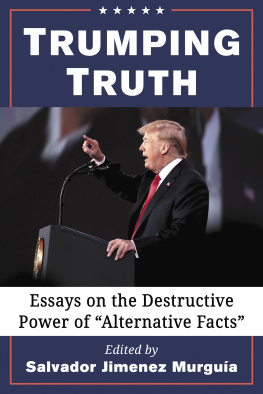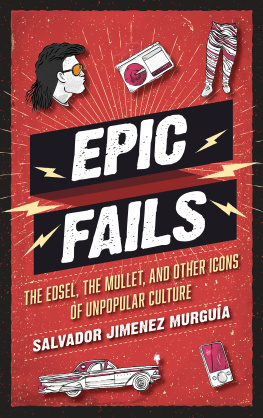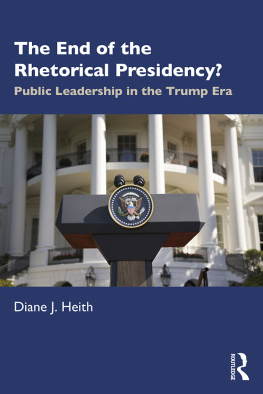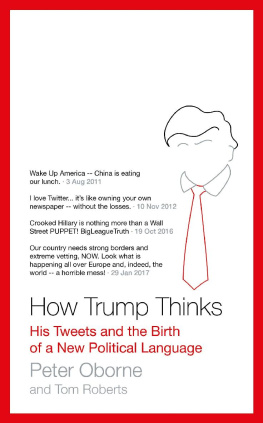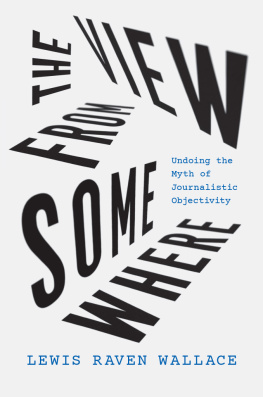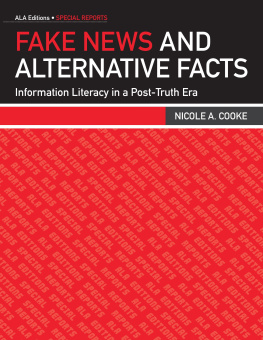
Trumping Truth
Essays on the Destructive Power of Alternative Facts
Edited by
SALVADOR JIMNEZ MURGUA

McFarland & Company, Inc., Publishers
Jefferson, North Carolina
LIBRARY OF CONGRESS CATALOGUING DATA ARE AVAILABLE
BRITISH LIBRARY CATALOGUING DATA ARE AVAILABLE
e-ISBN: 978-1-4766-3765-5
2019 Salvador Jimnez Murgua. All rights reserved
No part of this book may be reproduced or transmitted in any form or by any means, electronic or mechanical, including photocopying or recording, or by any information storage and retrieval system, without permission in writing from the publisher.
Front cover: President Donald Trump speaking at the Conservative Political Action Conference (CPAC) in National Harbor, Maryland, on February 23, 2018 (photograph by Gage Skidmore)
McFarland & Company, Inc., Publishers
Box 611, Jefferson, North Carolina 28640
www.mcfarlandpub.com
To Factmay you endure, survive and
return to the United States of America safely.
Acknowledgments
I would like to thank Susan Kilby, Managing EditorDevelopment, of McFarland for her consideration, support and advice in getting this project off the ground. She and her fellow staff were professional and a pleasure to work with.
This volume would not have been possible without the hard work and focus of its contributors, who kept pace with the monthly, weekly, and eventual daily flood of alternative facts from the news coverage on the Trump administration. In a peculiar fashion, I know it was as interesting as it was daunting and demoralizing, yet each of you did a remarkable job in meeting demands for deadlines and documentsfor this, I applaud each of you, your courage and your efforts!
I would also like to express my gratitude and appreciation for all of the advice, insight, encouragement and inspiration of the many people that both watched and helped with seeing this project through to completion. I include among these individuals Dr. Peter McCagg, Dr. Chris Carl Enrique Hale, Dr. Mark Juergensmeyer, Dr. Adam Dodd, Dr. Amie Miller, Boar Pants, and Counselor Robert F. Alvarenga.
Finally, as always, I appreciate the support of family and friends that gave me a pass, rescheduled dates and events, filled in as baby-sitters, and simply understood that I needed time to read, write and edit. In this light, some very special thanks go out to Hide Murgua, Paul and Jan Jimnez, Adrienne Morales, Yoko Naganishi, Tomie Shiraishi, Debbie Lemos, Ernie Lemos, Gerald Villarreal, Christine and Terrance Plumb, Heather and Stephen Plumb, Kei-Sempei and Kaya Suzuki, Yukari McCagg, Bart Scott, Dori and John Ramirez, Jaime Mireles, John Ortiz, and Roberto Amador.
Preface
The topic for this volume emerged in the moments just after the election of President Donald J. Trump on November 8, 2016. Throughout his campaign, it became more and more clear that truth had gradually become secondary to lies. The racism, sexism, fear-mongering and the like that stoked the flames within the engine of Trumps campaign were always one or more positions removed from the truth, and due to the ceaseless barrage of what can only be characterized as blatant lies, it appeared that no person, outfit or otherwise was able to keep up with all of the falsehoods, assess the damage of their impact, or even challenge, much less correct them. The task was simply too daunting, and so what was lost in the milieu of shock and confusion that this particular election brought about was how trutha pillar of modern critical thoughtcould become such a trivial item to be tossed about, disregarded and even rendered impotent.
In reaction, I put out a call for contributors to this volume, asking them to take up the topic of truth and its otherwise indelible position and place in our society. Sorting through the various proposals I realized that it was not lost on any of them that truth was indeed under attack and merited an analysis that would ground the issue at hand, rather than simply follow the many bizarre antics of Trump and his administration that characterized so much of the mainstream medias coverage of U.S. politics. The contributors herein had no trouble adhering to this focus on truth and what we agreed upon was its new state of triage.
Along these lines, this volume deals with the precarious situation in which truth has been compromised in a variety of political spheres within the United States. Although this work is guided largely by the current Trump administrations abuse of factual informationharkening back to a specific incident in 2017 when Kellyanne Conway uttered the term alternative factscontributors to the volume have branched out in their interpretations of veracity, some making historical links to the current political climate, while others have anticipated a new (ab)normal future where truth will simply be something of an antiquated feature of our past. In this way, this volume is less of a critique of the Trump administration and more of a broad exploration of the fragility of truth and the potential implications, consequences and even the significance of why and, more importantly, how truth can matter.
Introduction
On January 22, 2017, Kellyanne Conway, counselor to the president under the newly inaugurated Trump administration, was featured on NBCs Sunday morning talk show Meet the Press with Chuck Todd. In what became a somewhat heated exchange, Todd probed into thenpress secretary Sean Spicers comments to the press on the day after the inauguration in which he stated that the viewers of the event were the largest audience to ever to [sic] witness an inauguration, periodboth in person and around the globe. In that moment, alternative facts were born and a somewhat new era fostering the irrelevance of veracity was forged.
Packed into this example are Trumps illusions of grandeur, Spicers angry embellishment, and finally Conways defense of a lie, all culminating in the administrations earliest issue of alternative factsan apparent semantic strategy that challenges substantiated facts and argues against them by offering up alternative factoids. Although the use of falsehoods is nothing new within politics, nor is the critical examination of themacademic and otherwisethe concerted effort to defend falsehoods in this way appears novel, increasing in use and of growing concern.
This volume explores alternative facts, some of their parallels in history, and implications for their future impact on American society. Drawing attention to the precarity of what constitutes truth in the era of the Trump administration, the 13 essays herein provide various interpretations of how it could ever be acceptable to be seemingly indifferent to the facts and, more important, why now? Given the ceaseless flow of falsehoods engendered by this administration, a major challenge for a volume like this is where to begin. As of December 2018, the Washington Post reported that President Trump had uttered more than 7,640 lies in his 710 days in office. The Fact-Checker Blog keeps strict track of every one of his false claims, noting at that time that he was averaging nearly 6.5 claims a day, up from 4.9 claims a day during his first 100 days in office. This, however, is merely one person; forging ahead and accounting for his entire administration, including his public affairs apparatus, the phenomena of generating falsehoods has become more of a cultural practice as opposed to some isolated instances.
Next page
